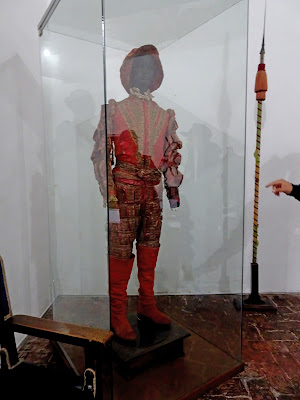8/29/2023 Tuesday
We met our guide, Flor Alba, at 7:00 for a Colonial Tunja tour. She was a lovely Colombian native, very energetic and informative. She spoke only Spanish so I interpreted about 40% of the content while Daniel handled the other 60%.
Our first stop was the Convent of Santa Clara la Real. This convent was the first established by the Spanish Empire in the New World, and dates back to 1571. Much of the original structure is intact, including the massive stone walls and some of the wooden doors.
We learned that when young women entered the convent they never again stepped outside of its walls, never seeing family or friends again. The best known resident of the convent was Francisca Josefa del Castillo who became known for her spiritual visions and writing. Her most famous work is the 753 page "Spiritual Affections".
We were shown her sleeping room, which was incredibly small. Most of it is taken up by her bed on the left. We were told that this was the largest such space in the Convent.
We were also shown her office, with an original desk and chair, and a small chest that would have been used to store writings.
While much of the Convent is now closed off as a museum, the church within the structure continues to be used for services.
Our second stop was Casa del Fundador (House of the Founder). This was the home of Gonzalo Suárez Rendón, the founder of Tunja. It is considered one of the finest examples of a 16th century home of a Spanish aristocrat. Construction on the home began in 1540.
The home is very large, and built around a courtyard garden. This was common for these estates as the garden provided food as well as a beautiful place to relax or entertain. It was also used as the bathroom!
The walls and ceilings of the home were covered with various drawings, painting and murals. Most were covered with a white lime plaster at one time. Many of the paints utilized animal blood or other substances that were thought to cause illness or disease, so covering them with lime plaster was considered preventative. Some of the drawings and murals have been restored by removal of the plaster, but other areas have been left covered because of fear of damage during removal.
The ceilings were particularly bright and ornate.
We found it interesting that many of the murals included animals not native to South America. The local artists who painted the murals were working only from sketches or descriptions, so some of the animals were not particularly accurate!
The bedrooms were large and ornate, and there were several displays of historical items.
Our tour lasted about three hours, and ended at a small café where we enjoyed coffee, hot chocolate and various pastries with our guide Flor. Many of the pastries in Colombia are cornmeal based rather than flour based. Apparently corn is a more successful crop in the Andes. Each of the wicker baskets in the picture below contains a different pastry, but all are essentially baked or fried cornmeal.
In the café I tried on a Colombian Ruana, a thick wool garment that we'd seen many of, especially in the colder high elevations. Tunja is at 9200 feet elevation, so definitely qualifies.
Daniel recalled fondly the several Ruanas that he owned as a child. They were used not only as warm garments but also as blankets, sleeping pads, and various other things.
We thanked Flor for a wonderful tour and returned to our hotel. We checked out and hit the road around 10:30, stopping around 11:30 for the best Arapenas in Colombia. Arapenas are a traditional Colombian dish (or snack) that are found throughout the country. They are like thick corn tortillas with cheese and sometimes other items baked in. They were very good.
We were changing lodging again today, and headed for the town of San Francisco. We had a long drive, and stopped at around 2:30 for lunch. Rural Colombia is really not set up for tourism, and we found it useful to be able to read and speak at least a little Spanish.
As we approached San Francisco we found the main road closed due to landslide. Daniel was surprised that the lodge owner hadn’t mentioned it as he had just spoken with her the previous day! He called her and after her profuse apologies for not mentioning the closure, she gave instructions for taking the old road to town. However we ended up following two men in a jeep down a steep, narrow one-lane road with incredibly tight curves. We finally made it into town but Daniel was not amused. We later found the correct "old route" and it was much better!
We stopped into a private residence called The Enchanted Garden for an hour.
It was a small garden with dozens of feeder, mostly for hummingbirds.
We saw a lot of Black-throated Mangos with some Rufous-tailed and Indigo-capped Hummingbirds, and a White-vented Plumlateer (also a type of hummingbird). The sun was in our face so not optimal for picture taking, but a beautiful garden and nice place to spend some time.
We arrived at our next lodge, Cabañas Aire Libre at around 6:15. They were very nice separate cabins with the main house used for breakfast. The owner was a very nice lady who was so apologetic to Daniel for not warning him about the closed road. We relaxed, had dinner, and got caught up on two days worth of bird lists.
Next - Laguna de Tabacal

























The paintings and murals are beautiful in the Casa del Fundador (founders House)
ReplyDeleteI was really surprised they were not protected from the elements. Some of them were in full sun coming from the windows.
ReplyDelete